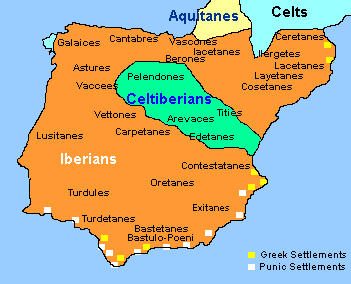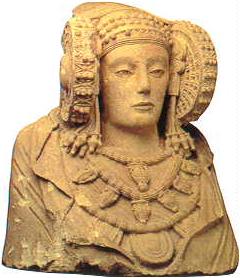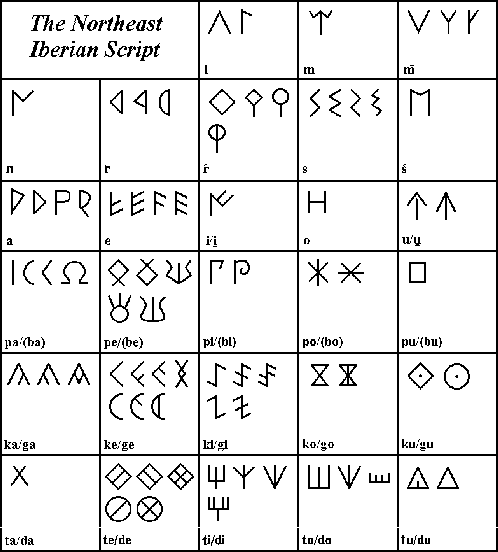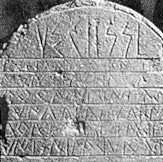§ 1. Mediterranean Languages and Their Relations.
This term "Mediterranean" is not a name of a family or a group of languages connected by genetic origin. The origins of most of those languages are unknown, or only suggested, and "Mediterranean" means the grouping by location. All ancient pre-Indo-European tongues of Southern Europe and islands in the Mediterranean Sea which cannot be classified among all known linguistic families are called Mediterranean.
This group is maybe the most mysterious block of world languages. Inscriptions, glosses, substratum elements in modern European languages, personal names which remained in ancient sources - that's all we can analyze and make our opinions by. All languages which used to flourish on the shores of the South European seas, are now dead. The only one that remains alive and prospering is Basque, the Euskara language which, though studied thoroughly and deeply, cannot still be identified within any language family.
Documents of Mediterranean languages, which are found by now, were written in three types of scripts: hieroglyphic, syllabic and alphabetic writing systems. According to those sources, all such languages are divided into three potential subgroups: pre-Indo-European tongues of the East Mediterranean, pre-Romance non-Indo-European languages of Italy, and finally the languages of the ancient Pyrenean peninsula. The pre-Hellenic speech of East Mediterranean is represented by Cretan hieroglyphic script language (late 3rd - early 2nd millennium BC), the language of the pictogram script of Phaistos Disk (the 17th century BC), the language of Cretan Linear A script (the 16th century BC), Cypro-Mynoan language (15 - 14th centuries BC), and some other minor languages fixed on Cyprus and Crete among their pre-Greek population. The structure of these languages cannot yet be deciphered and analyzed, though numerous attempts are being made all the time, including different Web sites under the headings like "Linear A is solved!" and similar ones. There are, certainly, plenty of versions, but we will come to them later.
The Pre-Romance non-Indo-European languages of ancient Italy include first of all the famous Etruscan speech which we already tried to analyze somehow in one of our previous issues. The Rhaetic language and the language in which the Lemnos stele was written are believed to be close to Etruscan (see Lemnos stele), and the single "Tyrrhenian group" of languages is sometimes formed to unify these three tongues. They have evident similarities in phonetic system, noun morphology, syntax. Some scientists (e.g. I. Diakonov in Russia) suggest the same origin of the Hurrite language spoken in East Asia Minor. But anyway, Italian ancient tongues are still a problem of origin, structure and classification.
And finally the third subgroup that will be a subject of this very article: the pre-Indo-European languages of the Pyrenean peninsula. They were spoken by quite numerous groups of people, people who established powerful states and were well known in the ancient world. They had (perhaps some of them) their writing system and made quite a lot of inscriptions. But still despite all that those Pyrenean languages disappeared quite easily in the beginning of the new era, and left so few signs in modern languages of the area that we can hardly identify the very system of them, and practically unable to decipher them and to classify them.
Those languages were namely Iberian and Lusitanian, and this will be
the topic for today.
§ 2. The Geography
and History of Iberians.
The Iberian Peninsula, comprising Spain and Portugal, takes its name
from them. The origin of the Iberians is still largely a matter for conjecture.
Some scholars suggest that the region around the Ebro River (in ancient
times the Iberus) is the most likely place of origin; others theorize that
the Iberians migrated to the Iberian Peninsula from North Africa sometime
between 4000 and 3500 BC. The well known theory states that the autochtonic
population of South Europe all came from Africa, the the so-called Mediterranean
race was common both in Europe and North Africa before Indo-Europeans came.
However, cultures of Africa and Europe do not show much in common.
 The
first historical references to the Iberians, made by Greek colonists settled
along the Mediterranean coast of the peninsula, date from the 6th century
BC. But the first to contact with them and told the world about the Iberian
civilization, were Phoenicians who began to colonize the shores of Iberia
already in the 11th century or even earlier. Phoenicians established a
great number of colonies along the coast for trading purposes and set up
friendly merchant relations with ingenious people of the country. Some
believe the very word "Hispania" derives from the Semitic stem "hidden,
concealed, remote". Phoenicians were the greatest factor of fast development
of the Iberians who used to be wild tribes and now began to turn into a
civilized nation. Especially it concerned the southernmost tribal communities
of them, which had wider contacts with Phoenician colonies. The writing,
introduced by Phoenician, was acquired by Iberians, then reconstructed
later with the help of the Greek alphabet, and this is the way Iberian
scripts appeared.
The
first historical references to the Iberians, made by Greek colonists settled
along the Mediterranean coast of the peninsula, date from the 6th century
BC. But the first to contact with them and told the world about the Iberian
civilization, were Phoenicians who began to colonize the shores of Iberia
already in the 11th century or even earlier. Phoenicians established a
great number of colonies along the coast for trading purposes and set up
friendly merchant relations with ingenious people of the country. Some
believe the very word "Hispania" derives from the Semitic stem "hidden,
concealed, remote". Phoenicians were the greatest factor of fast development
of the Iberians who used to be wild tribes and now began to turn into a
civilized nation. Especially it concerned the southernmost tribal communities
of them, which had wider contacts with Phoenician colonies. The writing,
introduced by Phoenician, was acquired by Iberians, then reconstructed
later with the help of the Greek alphabet, and this is the way Iberian
scripts appeared.
The 9th century was the time for the Tartessian culture to appear and soon to become one of the most developed powers in Europe of that time. Tartess has always been considered as the mystery number one in Spanish history. This state existed until the 5th century BC, and was developing under the strong influence of Phoenicians, their culture and traditions. Some linguists used to suggest last century that Iberians were just the mixture of Phoenicians and aborigines, but now this theory is left, I think fairly. It seems probable that Tartessians were not immigrants but a local nation, though in this period some of them could mix with Syrians, Phoenicians, Achaeans. That was the time of "Sea Peoples" migrations in the Mediterranean, and Tartessians could be one of these peoples. V.Poulter mentions the name from the bible sounding like Tarshish , and that's another theory.
Tartessians used writing since the 8th century, according to Strabo, had their written laws, coins, wide trade with all Mediterranean countries, Britain and northern Europe. But all that began to decline with the rise of Carthago, which developed as a great trading sea power and occupied all trading ways that used to be Tartessian profits. In 500 BC Tartess was no longer a serious power, and Iberians had to get back to their original tribal life, though more civilized than before.
Later data, recorded mainly by the Romans, who gained possession of the peninsula as a consequence of the Second Punic War, reveal that by the 3rd century BC the Iberians had become mixed with Celtic invaders from the east, producing the so-called Celtiberians; the present-day Spanish are in part descended from these Celtiberians. Celtiberians did not have broad contacts with Tartessians and their higher culture and that's why remained tribes until Romans came here. Celts were the first Indo-Europeans who came to settle in Hispania, and the mixture making Celtiberians was really a strange language conglomerate that needs to be studied deeper (see Celtiberian language description). Anyway, Celts pushed Iberians from the northern and central Hispania, and also assimilated them in southern France where Iberians used to live as well (Iberian inscriptions and remains of settlements were found there).
Knowledge of the Iberians of Spain has been gained mainly from cross-dating of their coins and pottery. Iberian pottery has been uncovered in parts of France, Italy, and North Africa, brought there originally through trade and travel.
 It
is widely supposed that the Iberians were generally short and dark-skinned;
their anthropological type is sooner African than European; but they were
of the white race for sure - just take a look at the famous Elche's Lady,
one of the most beautiful Iberian sculptures. Primarily they were agriculturists
(some were also miners and metalworkers); that quite possibly they lived
in and around politically independent city-states; and that undoubtedly
they possessed a sophisticated written literature. Their culture, although
earlier indebted to the Carthaginians and Greeks who had colonized Spain
before the Romans, had reached a high level by the time of the Roman conquest.
Little of it survived the overpowering influence of Rome.
It
is widely supposed that the Iberians were generally short and dark-skinned;
their anthropological type is sooner African than European; but they were
of the white race for sure - just take a look at the famous Elche's Lady,
one of the most beautiful Iberian sculptures. Primarily they were agriculturists
(some were also miners and metalworkers); that quite possibly they lived
in and around politically independent city-states; and that undoubtedly
they possessed a sophisticated written literature. Their culture, although
earlier indebted to the Carthaginians and Greeks who had colonized Spain
before the Romans, had reached a high level by the time of the Roman conquest.
Little of it survived the overpowering influence of Rome.
In the 1st century AD Strabo described Iberians and told that Turdetanes
were the most cultured among them, "they know writing and have documents
devoted to their history, poems and laws written in verse, as they say,
6000-year-old". Strabo mentioned the majority of the tribes that you can
see on the map here, but at that time they were all under Roman rule, though
often rebelled. In about a century they were gradually assimilated, lost
their language and became history. Tacitus tells us about an Iberian citizen
who spoke to Romans in his mother-tongue, after he killed a praetor. This
was the last sign of using Iberian language in the literature.
§ 3. The Iberian
Language and Its Origins.
The Iberian language is witnessed in inscriptions dating back to the
4-3th centuries BC. It is not clear whether it had many dialects or not.
Strabo says Iberians spoke different languages, but as he again said their
writing was also different we can suppose there were just dialectal differences
- the fact is that writing has several varieties but they are all forms
of one script. The inscriptions represent at least two main dialectal groups
of the language - the north-eastern, on the territory along the Mediterranean
coast from France via Valencia and then deeper in Castile, and southern
(mainly in Andalusia). The Iberian script was made to suit both single
phonemes and syllables, so we can trace all sounds of Iberian phonetics.
The language had vowels a, e, i, o (that's a pity for those who would like to relate Iberian with Etruscan and Rhaetic, because they both did not have o sound.). No diphthongs can be found in it. As for consonants, Iberian used sonants l, r, m, n, voiced explosives b, d, g, their unvoiced counterparts p, t, k, aspirated consonants h and th, and finally spirants - s, s', z. Aspirated were not so numerous as in Etruscan, palatals were not so numerous as in Basque, and in general the phonetics does not find any correspondences among European known tongues.
 There
is not much known about the morphology. All we know is forms of the verb
eban or ebanen with unclear grammatical meaning
and semantical meaning like "died, was buried" or something like that.
Anyway, burial stones practically always mention this stem. It seems like
Iberian was agglutinative and formed morphological categories by postfixes
adding directly to the stem. Of them, the postpositive element mi
is known with the supposed meaning of possession, and not only "my", but
"his", "her", "their" etc. It is believed to act somehow like English possessive
case (e.g. Gargori mi = Gargoris's). Iberian was much more
analytic than Latin, as some Roman historian mentions Iberians could not
understand Latin numerous inflected forms.
There
is not much known about the morphology. All we know is forms of the verb
eban or ebanen with unclear grammatical meaning
and semantical meaning like "died, was buried" or something like that.
Anyway, burial stones practically always mention this stem. It seems like
Iberian was agglutinative and formed morphological categories by postfixes
adding directly to the stem. Of them, the postpositive element mi
is known with the supposed meaning of possession, and not only "my", but
"his", "her", "their" etc. It is believed to act somehow like English possessive
case (e.g. Gargori mi = Gargoris's). Iberian was much more
analytic than Latin, as some Roman historian mentions Iberians could not
understand Latin numerous inflected forms.
The Lusitanian (or South Lusitanian) language left some inscriptions written also in Iberian script. It should be related o Iberian, but the structure of the language remains unknown. All ancient authors identify Lusitanians as an Iberian tribe, so we can suppose their languages were similar.
The Iberian origins are not defined, and an argument between various theories has not turned into the truth yet. The majority believe Iberians could come from North Africa and spread in Hispania, Southern France, Corsica, Sardinia, Sicily. Ancient Sardinian language and languages of Sicelian tribes in Sicily are not studied deeply enough to judge for sure, but the ethnic features as ancient documents witness give us a chance of unifying them in one language group. So Iberians could be immigrants in Europe from Africa, who came here and assimilated autochtonic population. The Iberization did not touch the north-west of the Pyrenean peninsula, where Basques (Vascones) used to live at the moment and continue to live nowadays. All attempts which have been made since the 19th century in linguistics to prove any genetic similarity of Basque and Iberian seem to have been unsuccessful. The most probable variant is that Basque nation is the synthesis of aboriginal tribes who used to be more numerous in Europe in a very ancient epoch. Anyway, the contacts of Iberians and Basques were history already when Greeks came here in the 6th century BC.
 Basques
can sooner be close to Aquitans who lived in South France until Romans
came. Aquitans, who spoke also an unknown language, were very short and
black-haired, the same as Iberians, but the toponimic names do not show
similarity in Iberian and Aquitanian. And nowadays linguists are able to
choose Iberian loanwords in Basque and in Spanish to prove, that those
three languages were different.
Basques
can sooner be close to Aquitans who lived in South France until Romans
came. Aquitans, who spoke also an unknown language, were very short and
black-haired, the same as Iberians, but the toponimic names do not show
similarity in Iberian and Aquitanian. And nowadays linguists are able to
choose Iberian loanwords in Basque and in Spanish to prove, that those
three languages were different.
Another interesting theory gets us to Caucasus. The phonetics and syntax
of Iberian, as well as Basque, are much alike some processes in South Caucasian
languages, especially of Kartvelian group. Greeks called today's Georgians
also Iberians. In general Caucasian tongues play important role in the
studies of Mediterranean languages - many linguists referred to them as
the related languages: Etruscan can be related to Hurrite, Cretan languages
show something in common with Hatti, and Hatti - with Georgian. The same
goes with Iberian, but the material is too scarce to prove something.
§ 4. The Iberian
Substratum in Spanish, Portuguese and Basque.
The Roman conquest delivered a completely new civilization to the peninsula.
Romans came with their language, an Indo-European Italic tongue which began
to influence strongly native tongues of the country. It is supposed that
local languages of Spain and Portugal could not but leave some elements
in later speech. And not only the vocabulary is subject to such mutations,
but the phonetics and the morphology as well. Do not forget that Celtic
languages of those who came to Iberia and became Celtiberians then changed
greatly due to aboriginal influence (see
Celtiberian language description). In Spanish there is a number of
different phenomena the nature of which cannot be explained within the
development of Latin and Romance linguistics, and that's why such processes
are often said to mean Iberian traces in Spanish.
The Spanish s sound is somehow special and dissimilar to correspondent phonemes of other Romance tongues. The palatal Iberian consonants which influenced Celtiberian and turned its s into š (compare Gaulish noun endings -os, -es, -abos with Celtiberian -oš, -eš, -uboš), must have influenced also Spanish which led to this specific s. Another thing, now concerning the morphology, deals with Spanish word productive suffixes, some of which are really unique.
But certainly the most visible trace the Iberian language left in the
vocabulary. The question about this substratum lexics is very complicated,
because the very definition of pre-Romance substratum is based on the similar
words in Spanish and Basque and their absence in all surrounding languages.
Here is the list of words which are defined by linguists as certain Iberian
substratum:
abarca - leather shoes (Gascon abarque,
Basque abarka)
arrugia - underground way (Modern arroyo)
artica - uncultivated plain
balsa - pool, swamp (Old Portuguese balsa
- vat)
balucem, baluz - gold sand (the word was mentioned by
Plinius in Roman times)
bruja - witch (Portuguese bruxa)
cachorro - puppy, cub
calambre - cramp
cuscolium - holly fruit (Modern coscojo)
esquín - little salmon (Basque izoki
- salmon)
García - family name
gusa - a worm (Basque usan, uzan, Berber
akuz, takuzt, takust)
helecho - a fern (Basque hiratz)
izquierdo - left (Portuguese esquerdo,
Basque ezkerr)
lama - swamp, mud
lancea - a spear (Modern Spanish lanza)
lausia - burial stone (Modern Spanish losa,
Potuguese lousa)
légamo - silt
loco - crazy
manteca - lard
mozo - a surf
muga - border
nata - cream (Catalan mato)
nava, Basque naba - a mountain valley (Navarra
comes from here)
páramo - empty plain, valley
pestaña - eye-lash (Portuguese pestana)
rebañe - herd
sabandija (from *sege-andere-a - girl-snake)
- leech (Basque sugandilla, suangilla - lizard)
sapo - toad
sarna - itch
sarralia - lettuce
ura, Basque ur - water, stream
vega, Old Spanish vaica, Basque ibaiko
- a river bank
Here we mentioned Spanish,
Portuguese,
Basque, Gascon (dialect of Occitan)
and Catalan
languages, of them the last is the least influenced by Iberian; Catalonia
was inhabited partly by Celts, then Roman colonies were much stronger there,
closer to Gaul. But the fact is that complete Iberian vocabulary (including
toponimics, personal names, glosses and word stems) makes about 1,000 words.
And practically no cognates from other language groups - Iberian remains
mysterious and strange.
Once a powerful civilization, which conducted war with Egypt, raided the shores of Asia Minor, once a leading trading power which sent its ships to Britain and Syria, traded with Europe, Asia and Africa, once a strong and wary people which made the best units of Gannibal's army on the field of Cannae - Iberians then disappeared, taking their secrets with them. But still they could not take their culture, their traces, their language. I am sure that the language will be finally interpreted, all inscriptions deciphered, and we will write another page of ancient European linguistics and its relations with Indo-European languages of Europe.